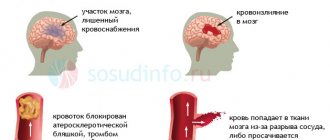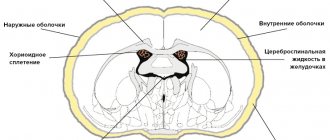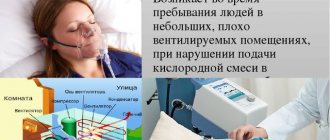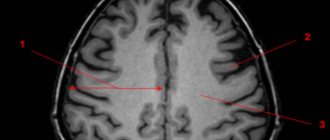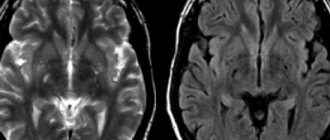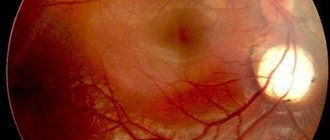Symptoms of cerebral atherosclerosis
Unfortunately, cerebral atherosclerosis may not manifest itself for years. Only regular examination and monitoring of blood sugar and lipid levels helps to recognize the impending danger in time and take effective measures.
Entrust your health to the professionals of the multifunctional center of the FMBA of Russia with extensive experience in the treatment of patients with vascular pathology, as well as prevention and subsequent recovery. Annual monitoring of your health will help you prevent vascular accidents in time and maintain a high quality of life for many years.
Below is Table 1 with the most common symptoms of cerebral atherosclerosis at different stages of the disease. It will help you recognize the first signs of pathology and promptly seek medical help.
| Stage | Patient complaints |
| First stage | Often : headache, tinnitus, memory loss (remembers the past well, but cannot remember new information. Often : asthenia - fatigue, weakness, inattention, general lethargy. Relief may occur after rest. Rarely : sleep disturbance, insomnia or daytime sleepiness. |
| Second stage | Disease progression . Anxiety, suspiciousness, mood swings, and a tendency toward depression appear. Memory loss: a person does not remember what happened today and stops thinking clearly and logically. Headache and tinnitus become constant. Speech: unclear, diction changes. Tremors of the limbs and head appear. Vision and hearing deteriorate. Coordination in space deteriorates: dizziness and unsteadiness of gait are bothersome. There may be a loss of sensitivity in one half of the body and the appearance of facial asymmetry. |
| Third stage (irreversible) | Dementia develops . The patient may behave like a child or become whiny and aggressive. Not interested in the world around him and the events in it. Not oriented in space and time. There is complete or partial memory loss. Needs constant care because he has lost self-care skills at home. |
Such complaints may indicate that the lumen of an important vessel in the brain is closed by more than 50%. Be attentive to your health!
Self-medication of cerebral atherosclerosis is not acceptable!
Even at the first stage! As we said above, the first symptoms of the disease appear already with a significant degree of vascular damage.
Entrust your health to specialists with many years of experience in the treatment of vascular accidents and subsequent neurorehabilitation. Start by seeing a neurologist and tell him about how you have been feeling over the past months.
A professional, sensitive attitude towards patients and attention to detail will allow us to recognize and prevent irreversible changes in the brain in time.
Indications for intervention
- Narrowing of the vascular lumen by more than 50-60%.
- Symptoms of microstroke and stroke.
- High risk of complications with other vascular interventions.
The operation is also performed for patients who have already undergone surgery to remove plaques, but are faced with a relapse of narrowing of the arterial lumen.
Stenting is not performed if:
- complete blockage of the carotid artery,
- allergies to the drugs used.
Also, surgery is not prescribed for cerebral hemorrhages that occurred within the last 2 months or for heart rhythm disturbances.
| Type of intervention | Price |
| Stenting of cerebral vessels | 300,000 - 450,000 rub. |
Request a call back Get a free consultation
Diagnostics
A neurologist deals with cerebral atherosclerosis. His task is to collect anamnesis, as well as conduct a series of tests. Doctor:
- will ask you to look up (a sick person will not be able to fulfill the request);
- will check the reflexes (they will be either excessively high or low, and asymmetrically);
- will ask you to stretch your arms forward and look to see if there is any tremors in the fingers, or if the patient is losing balance;
- will ask you to touch your nose with the tip of your finger with your eyes closed (the patient will not be able to cope with this task).
This is only a small component for assessing the patient’s health. Therefore, more detailed examinations are required next:
- consultation with an ENT doctor, ophthalmologist and other specialists depending on the identified disorders;
- biochemical blood test for triglycerides and cholesterol (lipid spectrum);
- According to indications, instrumental examinations are carried out.
To assess the condition of cerebral vessels, the following is carried out:
- Ultrasound of the brain and neck using two-dimensional and transcranial duplex scanning technology;
- angiography of cerebral vessels;
- Doppler ultrasound;
- MRI of the brain in vascular mode;
- REG (radioencephalogram);
- CT computed tomography of the brain and blood vessels;
- EEG – electroencephalogram.
The diagnostic capabilities of our multifunctional center of the FMBA of Russia allow us to carry out not only these, but also any other examinations necessary for the patient using the most modern and accurate equipment. You will be able to get advice from related specialists on any clinical case, including suspected cerebral atherosclerosis.
MRI of cerebral vessels - indications and contraindications
MRI of head vessels, 3D model
Scanning is carried out on the recommendation of a doctor. The results of the study may be required to draw up a complete clinical picture of an already diagnosed disease, study the consequences of an injury, identify the causes of chronic poor health, and confirm the doctor’s suspicions.
MRI of cerebral vessels should be done if a person has complaints about:
- repeated fainting;
- progressive deterioration of vision or hearing;
- constant dizziness;
- headaches of unknown origin;
- noise, especially pulsating, in the ears or head (ringing, whistling, squeaking);
- convulsions;
- disturbances of sensitivity and movement in the limbs, trunk, face;
- sleep disorders (insomnia, problems falling asleep, waking up at night);
- frequent nosebleeds;
- memory impairment;
- loss of balance, lack of coordination of movements;
- acute exophthalmos (protrusion of the eyeball);
- signs of intracranial hypertension.
An examination may be required at the stage of planning an operation, after surgery, to monitor the disease over time (tumors, atherosclerosis, thrombosis, etc.), as well as to monitor the effectiveness of prescribed therapy. Usually the procedure is carried out as planned.
Contraindications for MRI of cerebral vessels is the presence of metal implants in the patient (pacemaker, hemostatic clips, prostheses, etc.). If there are foreign bodies made of titanium (plate, dentures) in the area being examined, it is necessary to provide a document that confirms the material. The corresponding statement can be obtained from the clinic where the operation was performed.
Scanning results can be negatively affected by braces and hearing correction devices. These must be notified to the X-ray technician prior to the procedure.
The following conditions are considered relative contraindications:
- first trimester of pregnancy;
- weight more than 120 kg;
- fear of confined spaces;
- neurological disorders accompanied by uncontrolled body movements;
- severe pain syndrome.
If you are claustrophobic or overweight (if the patient's body weight exceeds the carrying capacity of the tomograph conveyor), you can perform the study on an open-type device, however, such devices have less accuracy (compared to contour ones).
In case of acute pain syndrome, hyperkinesis (when a person cannot control movements), it is suggested to undergo diagnostics in a hospital setting under sedation.
It is necessary to take into account how MRI of cerebral vessels is performed: with contrast, the number of contraindications does not increase, with the exception of women during pregnancy. The latter category of patients cannot use even safe drugs based on gadolinium chelates. The indicators are usually well tolerated, but to reduce autonomic reactions the patient needs a light meal 45 minutes before the scan.
Treatment of cerebral atherosclerosis
It is not only the neurologist who treats patients with atherosclerosis in our center. We treat the disease comprehensively with the involvement of doctors from different specialties. This approach makes the recovery process comfortable, gives better results and helps patients return to their normal lives sooner.
The basis for the treatment of cerebral atherosclerosis is the correct selection of nutrition. On the one hand, the diet combines a complete diet with individually designed physical activity. On the other hand, medications help compensate for the pathological process and reduce the harmful effects of the disease on the body.
Medicines used:
- diuretics;
- drugs that normalize lipid and blood sugar levels;
- vitamins;
- drugs to improve cerebral circulation;
- means for normalizing blood pressure and heart rate;
- thrombolytic agents, etc.
Preparation for MRI of cerebral vessels
Visualization of individual cerebral vessels with MR venography
The examination does not require special actions from the patient the day before. There is no need to stop medications, follow a diet or a special daily routine.
When examining blood vessels with contrast, it is worth having a snack three quarters of an hour before the scan. Nursing mothers need to stock up on breast milk for 2 feedings, which they will have to skip after the procedure.
You should come to the clinic 10-15 minutes before the appointed time to fill out documents and prepare for the scan. You need to have a passport, a referral from a doctor, reports and photographs from previous similar studies, if any, with you. A person must warn the x-ray technician about:
- all your illnesses;
- drug intolerance;
- presence of claustrophobia;
- the presence of metal and electronic devices in organs and tissues (pacemakers, prostheses, etc.);
- tattoos.
Before scanning, the patient removes all jewelry and clothing with metal elements, including glasses, piercings, dentures, and hair clips. Electronic devices (phone, watch, hearing aid) will also have to be left outside the MRI room.
Before the scan begins, the laboratory assistant will give the patient a button for emergency communication. It must be pressed in case of any discomfort (dizziness, nausea, impaired consciousness, panic, etc.). As soon as the person gives a signal, the study will be paused and the radiologist will come to the rescue. The button looks like a rubber bulb and calls a laboratory assistant in a matter of seconds.
Prevention
Below are a few useful habits that will help significantly reduce the risk of developing atherosclerosis:
- to give up smoking;
- nutrition balanced in composition of nutrients;
- correction and maintenance of optimal body weight;
- annual preventive monitoring of lipid and blood sugar levels.
The diagnostic capabilities of our center allow us to establish a diagnosis quickly and accurately. Based on the results of the examination, you will be advised by experienced neurologists, whose knowledge has helped save hundreds of patients.
Also, individual health monitoring programs have been developed on the basis of the Federal Scientific and Clinical Center of the Federal Medical and Biological Agency of Russia.
- for men (under 40 years old, over 40 years old, standard);
- for women (under 40 years old, over 40 years old, standard based on age and optimal)
Don't put off taking care of your health. Call us or make an appointment to assess your risk of atherosclerosis and receive comprehensive recommendations.
MRI results of cerebral vessels
Such scanning of arteries and veins provides information in the form of images in three planes, and using 3D modeling, three-dimensional images can be obtained. By assessing the contours on the slides, the radiologist will notice any deviations from the norm and describe them in the report. During image analysis, the following can be detected:
- neoplasms (indirectly) and features of their blood supply;
- damage (ruptures) of blood vessels;
- areas of pathological narrowing of the lumen and tortuosity of the course of arteries or veins;
- localization and size of blood clots, emboli;
- signs of atherosclerosis;
- thinning and deformation of arterial walls (aneurysm);
- acute ischemia;
- consequences of stroke;
- inflammatory changes in the walls of blood vessels;
- arteriovenous malformations;
- cavernous angiomas;
- vasospasm, etc.
Visualization of blood vessels provides a deeper understanding of the processes occurring in brain cells. The procedure allows you to determine the true cause of migraines, dizziness, memory problems, and reveal the pathogenesis of serious brain diseases. The information obtained during MRA is extremely important for selecting treatment tactics and monitoring its effectiveness.
Causes of the disease
The reasons for the formation of primary vasculitis are still unknown to science. Secondary disease can occur against the background of:
- acute or chronic infection;
- genetic (hereditary) predisposition;
- thermal effects (overheating or hypothermia of the body);
- various injuries;
- burns;
- contact with chemicals and poisons.
Another cause of vasculitis can be viral hepatitis. One or more risk factors are enough to change the antigenic structure of tissues. In this case, the immune system begins to secrete antibodies, which further damage the tissue, in this case the blood vessels. This leads to an autoimmune reaction and inflammatory and degenerative processes.
